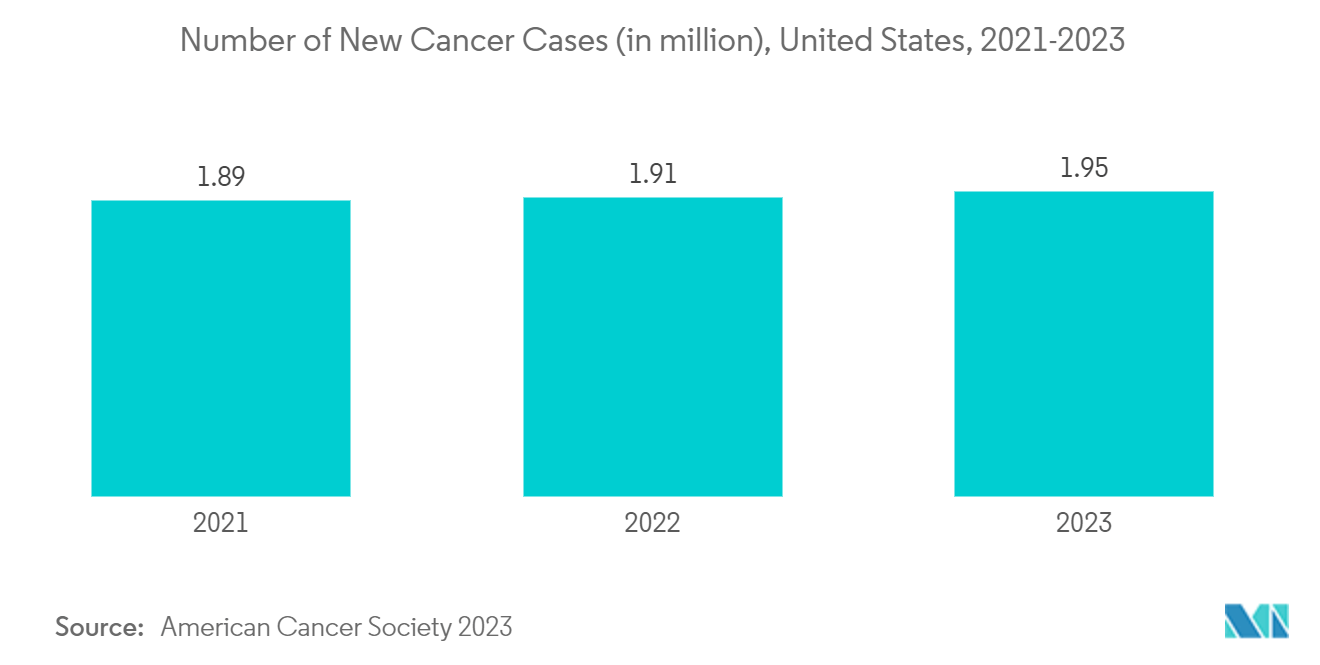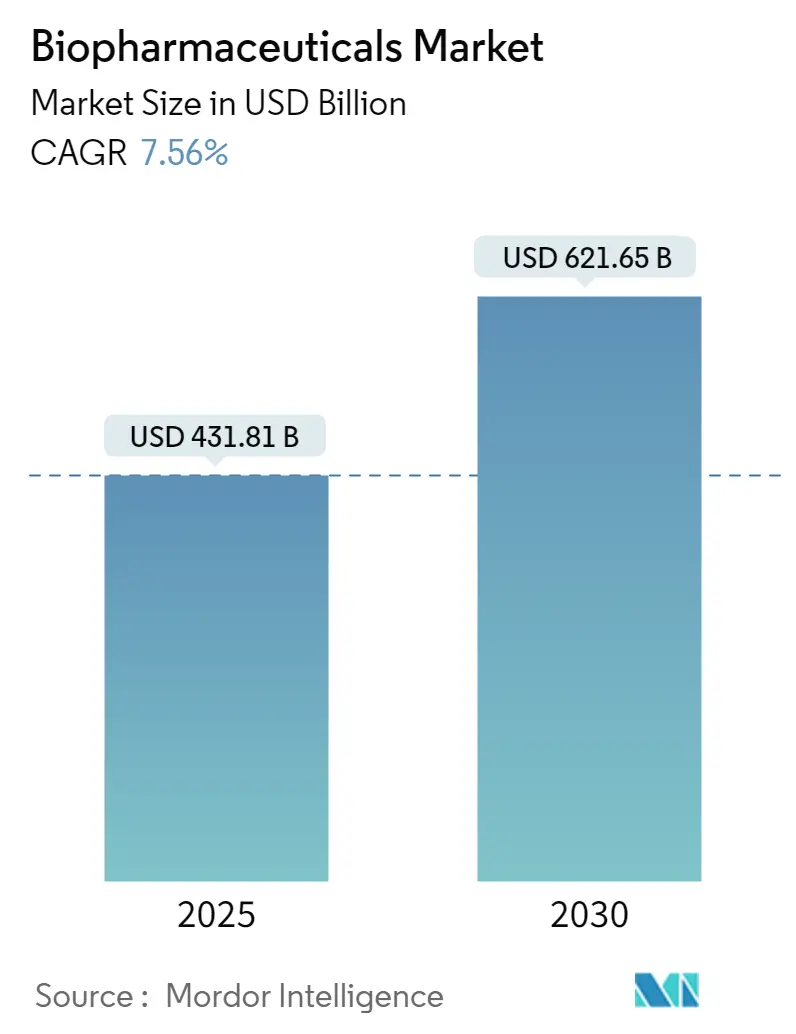
| Study Period | 2019 - 2030 |
| Market Size (2025) | USD 431.81 Billion |
| Market Size (2030) | USD 621.65 Billion |
| CAGR (2025 - 2030) | 7.56 % |
| Fastest Growing Market | Asia Pacific |
| Largest Market | North America |
| Market Concentration | High |
Major Players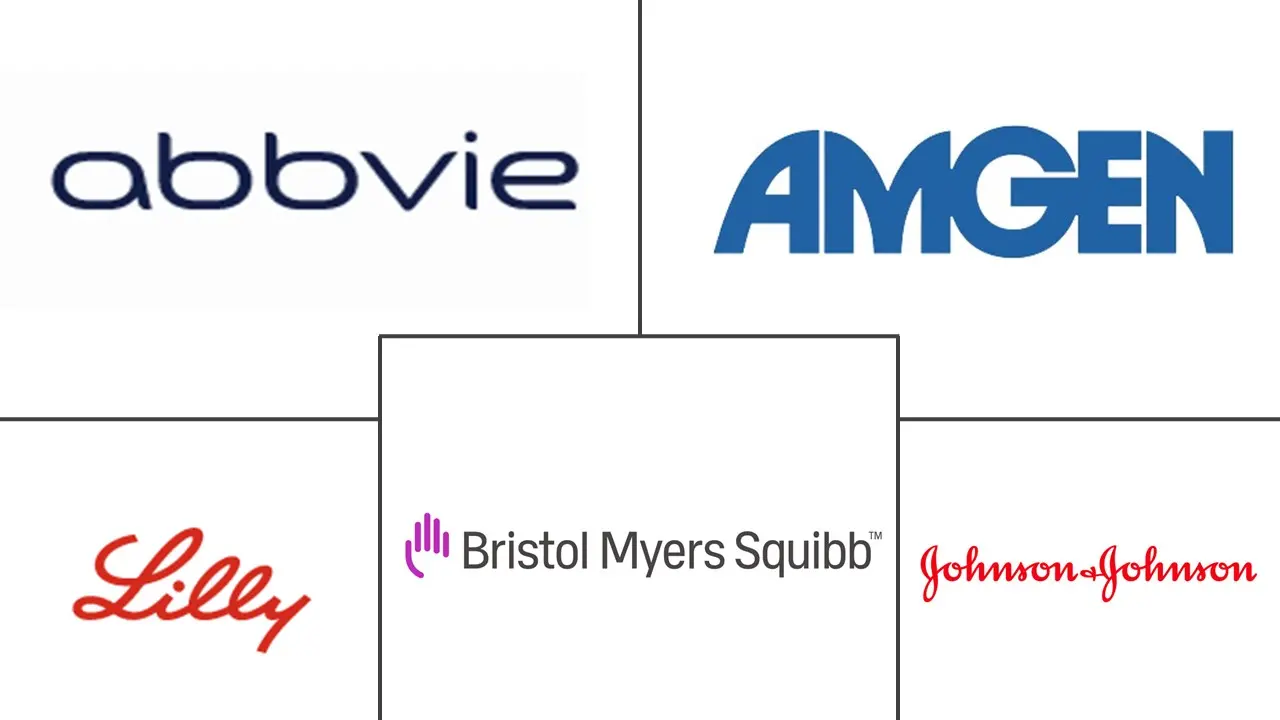
*Disclaimer: Major Players sorted in no particular order |
Biopharmaceuticals Market Analysis
The Biopharmaceuticals Market size is estimated at USD 431.81 billion in 2025, and is expected to reach USD 621.65 billion by 2030, at a CAGR of 7.56% during the forecast period (2025-2030).
The COVID-19 pandemic had a significant impact on the Biopharmaceutical industry. Thus, Biopharma Industry Trends shifted to most Biopharmaceutical companies striving extensively to develop vaccines against the SARS-CoV-2 virus. For instance, in June 2022, Pfizer announced a USD 120 million investment for its Kalamazoo (Michigan) facility, enabling United States-based production for its COVID-19 oral treatment, PAXLOVID (nirmatrelvir tablets and ritonavir tablets). The increased interest in manufacturing COVID-19 vaccines significantly added to the growth of the Biopharmaceutical industry during the COVID-19 pandemic. Following the stabilization from COVID-19, the increasing prevalence of chronic diseases is expected to further shift the Biopharma Industry Trends toward developing solutions for chronic diseases, driving the growth of the Biopharmaceutical industry.
Factors like rising chronic disease prevalence and increasing acceptance and demand for Biopharmaceuticals owing to their ability to treat previously untreatable diseases are driving the market's growth. For instance, in September 2022, a report by the WHO stated that about 55 million people worldwide are living with dementia, and nearly 10 million cases are reported annually. The WHO also highlighted that Alzheimer's is the most common form of dementia and constitutes about 60-70% of the total cases of dementia. As per the same source, most people who develop Alzheimer's dementia are 65 years and above. Such a high disease prevalence is likely to facilitate the demand for effective treatment, which in turn will bolster Biopharma Market Growth over the coming years.
The Biopharmaceutical Products' ability to address previously untreatable conditions has paved the way for introducing innovative drugs in the market. For instance, in September 2022, the Center for Biologics Evaluation and Research (CBER) approved Bluebird Bio, Inc.'s SKYSONA (elivaldogene autotemcel), a Gene Therapy indicated to slow the progression of neurologic dysfunction in boys 4-17 years of age with early, active cerebral adrenoleukodystrophy (CALD). Similarly, in June 2022, CBER approved GlaxoSmithKline's PRIORIX, a live vaccine for measles, mumps, and rubella. Thus, such product approvals increase the availability of novel drugs in the market, which is expected to boost the Biopharmaceutical Industry Growth over the forecast period.
Furthermore, in February 2022, Johnson & Johnson, one of the Largest Biopharmaceutical Companies, and its China-focused partner company Legend Biotech Corp. developed a therapy to treat a type of white blood cell cancer approved by the United States Food and Drug Administration (FDA). Thus, the development of new therapies that aid in treating oncologic disorders is anticipated to have a positive impact on the growth of the Biopharmaceutical industry over the forecast period.
Thus, factors such as rising chronic disease prevalence, product launches, and approvals over the forecast period are likely to facilitate market growth over the forecast period. However, high-end manufacturing and complicated and cumbersome regulatory requirements will hinder Biopharmaceuticals Market Growth over the forecast period.
Biopharmaceuticals Market Trends
Anti-cancer Monoclonal Antibodies are Expected to Witness Significant Growth Over the Forecast Period in the Biopharmaceutical Industry
Anti-cancer Monoclonal Antibodies (also called moAbs or mAbs) are a class of Biologics made in laboratories that act like antibodies and treat cancer. They work in different ways to kill cancer cells or inhibit their growth further. The rising usage of monoclonal antibodies and antibody derivatives in therapeutics to treat cancer is a key driver for the rapid growth of the Monoclonal Antibodies Market.
Growing approvals, clinical trials, and increasing research expenditure are major factors contributing to this segment's growth. For instance, in October 2022, PT217, a bispecific anti-Delta-like ligand 3 (DLL3)/anti-Cluster of Differentiation 47 (CD47) antibody, developed by Phanes Therapeutics, Inc., received Phase 1 clearance from the United States Food and Drug Administration (FDA). Phanes Therapeutics, Inc. is a clinical-stage Biopharmaceutical Research Company focused on oncology for patients with small cell lung cancer (SCLC) and other neuroendocrine cancers.
Additionally, the growing number of FDA approvals and new product launches for various indications will drive the segment. For instance, in January 2022, the FDA approved Kimmtrak for treating HLA-A-positive adult patients with unresectable or metastatic uveal melanoma, a rare type of cancer that originates in the eye. Similarly, in May 2022, Roche Pharma launched Phesgo, a combination of Monoclonal Antibodies, Perjeta (pertuzumab) and Herceptin (trastuzumab) with hyaluronidase, for the treatment of patients with breast cancer.
Thus, the Monoclonal Antibodies Market segment is likely to witness significant growth over the forecast period due to the above-mentioned factors.
North America is Expected to Hold a Significant Share of the Market Over the Forecast Period
As per Biopharmaceutical Analysis, the growing burden of chronic diseases, the rising geriatric population, and increasing investments in research and development activities in the region are the major factors driving the Biopharmaceuticals Market in North America. In addition, the presence of well-established Biopharmaceutical Companies and new product launches are also expected to boost market growth in the region.
The rising prevalence of chronic diseases in the United States is likely to facilitate market growth in the region. For instance, the Centers for Disease Control and Prevention's (CDC) data updated in July 2022 briefed that coronary heart disease is the most common type of heart disease, and approximately 20.1 million adults aged 20 and older suffer from the ailment in the United States. Additionally, per the CDC data, every 40 seconds, someone suffers from a heart attack, and nearly 805,000 people in the United States have a heart attack annually. Thus, the high burden of cardiovascular diseases demands the availability of advanced drugs for treatment, which is likely to boost the Biopharma Market Growth.
Furthermore, an increase in the incidences of chronic diseases among the Canadian population, as well as the comorbidities associated with the diseases, is expected to positively impact the growth of the Biopharmaceuticals Market over the forecast period. For instance, according to Statistics Canada, as of July 2022, almost one in five Canadians (18.8% of the population; 7,329,910 people) were at least 65 years of age. As the geriatric population is more prone to chronic diseases, the rising elderly population is likely to raise the demand for effective drugs for their treatment hence, expected to drive the market growth over the forecast period.
Furthermore, strategic activities such as acquisitions and rising investments by key market players to expand their footprint in the Biopharmaceuticals Industry are also expected to propel market growth. For instance, in May 2022, Eli Lilly and Company announced an investment of USD 2.1 billion to expand its manufacturing footprint in Indiana, United States. Similarly, in May 2022, LOTTE acquired Bristol Myers Squibb's manufacturing facility in East Syracuse, New York. The East Syracuse site will serve as the LOTTE Center for North America Operations for LOTTE's new Biologics contract development and manufacturing organization (CDMO) business in the United States.
Thus, due to the factors mentioned above, such as rising chronic disease prevalence and the company's investment and acquisition strategy, the studied market is expected to grow significantly in North America over the forecast period.
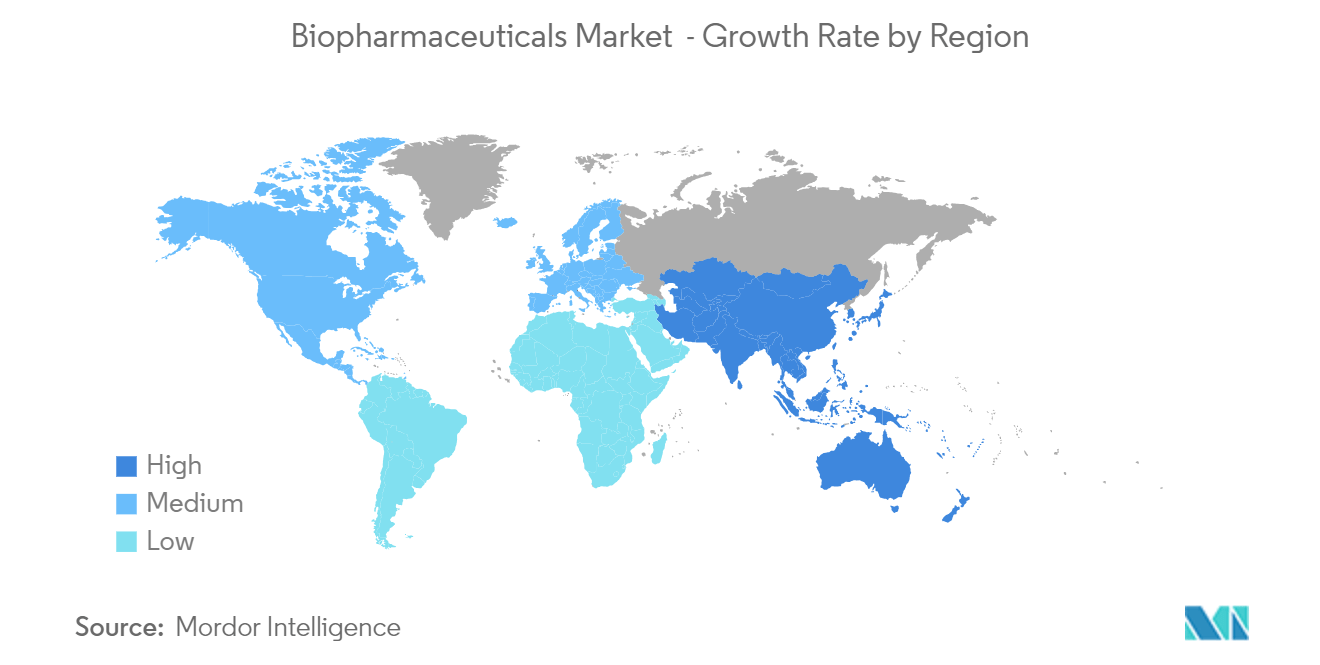
Biopharmaceuticals Industry Overview
The Biopharmaceutical Industry is fragmented in nature due to the presence of several companies operating globally. The competitive landscape includes analyzing a few well-known international and local companies, including some of the Largest Biopharmaceutical Companies that hold market shares. Furthermore, companies adopt various strategic measures such as acquisitions, partnerships, collaborations, and new product launches to expand in the market and enhance their Biopharmaceutical Marketing strategies. Some of the Largest Biopharmaceutical Companies in the industry include Amgen Inc., Eli Lilly and Company, Johnson and Johnson, Abbvie Inc., and Bristol-Myers Squibb Company, among others.
Biopharmaceuticals Market Leaders
-
Amgen Inc.
-
Abbvie Inc.
-
Bristol-Myers Squibb Company
-
Eli Lilly and Company
-
Johnson & Johnson
- *Disclaimer: Major Players sorted in no particular order
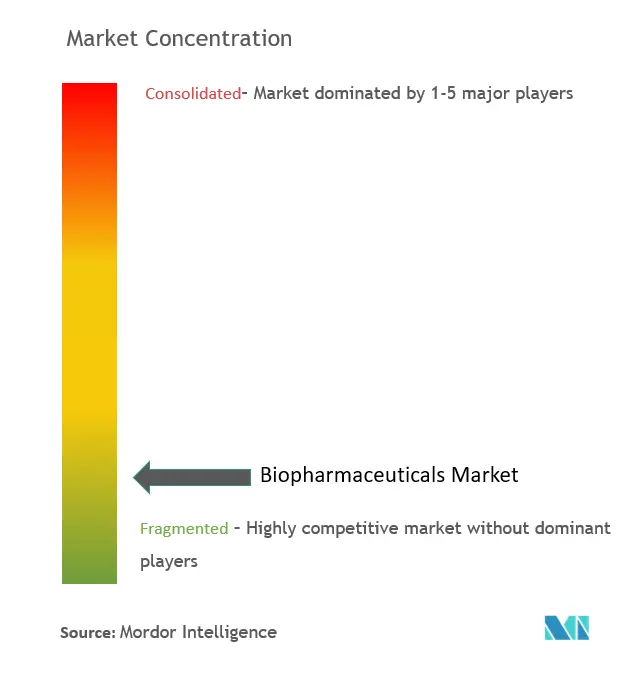
Biopharmaceuticals Market News
- July 2023: Pfizer invested USD 25 million in Caribou Biosciences to progress an immune-cloaked allogeneic CAR-T cell therapy, CB-011. The company is currently evaluating the cell therapy in a Phase I CaMMouflage clinical trial for relapsed or refractory multiple myeloma.
- April 2023: InflaRx N.V.'s Gohibic (vilobelimab), a first-in-class monoclonal anti-human complement factor C5a antibody, was granted an Emergency Use Authorization by the United States Food and Drug Administration for the treatment of COVID-19 in hospitalized adults when initiated within 48 hours of receiving invasive mechanical ventilation, or extracorporeal membrane oxygenation.
Biopharmaceuticals Industry Segmentation
As per the scope of the report, biopharmaceuticals refer to any biologically synthesized molecules used to treat or manage disorders. These are derived by recombinant DNA technology and produced in bacterial, yeast, insect, plant, or mammalian cell expression systems, hybridomas, or primary or continuous cell lines.
The biopharmaceutical industry is segmented by product type (Monoclonal Antibodies (Anti-cancer Monoclonal Antibodies, Anti-inflammatory Monoclonal Antibodies, Other Monoclonal Antibodies), Recombinant Growth Factors (Erythropoietin, Granulocyte Colony Stimulating Factor), Purified Proteins (Leukemia Inhibitory Factor (LIF), P53 Protein, P38 Protein, Other Purified Proteins), Recombinant Proteins (Serum Albumin, Amy loid Protein, Defensin, Transferrin), Recombinant Hormones (Recombinant Human Growth Hormones, Recombinant Insulin, Other Recombinant Hormones), Vaccines (Recombinant Vaccines (Cancer Vaccine, Malaria Vaccine, Ebola Vaccine, Hepatitis-B Vaccine, Tetanus Vaccine, Diptheria Vaccine, Cholera Vaccine, Other Recombinant Vaccines), Conventional Vaccines (Polio Vaccine, Pox Vaccine, Other Conventional Vaccines)), Recombinant Enzymes (Enterokinase, Cyclase, Caspase, Cathepsin), Cell And Gene Therapies (Allogenic Products, Autologous Products, Acellular Products), Cytokines, Interferons, and Interleukins, and Other Product Types), Therapeutic Application (Oncology, Inflammatory and infectious Diseases, Autoimmune Disorders, Metabolic Disorders, Hormonal Disorders, cardiovascular Diseases, Neurological Diseases, and Other Therapeutic Applications), and geography (North America, Europe, Asia-Pacific, Middle East and Africa, and South America). The report also covers the biopharmaceuticals market sizes and trends for 17 countries across major regions globally.
The report offers the value in (USD) for the above-mentioned segments.
| By Product Type | Monoclonal Antibodies | Anti-cancer Monoclonal Antibodies | ||
| Anti-inflammatory Monoclonal Antibodies | ||||
| Other Monoclonal Antibodies | ||||
| Recombinant Growth Factors | Erythropoietin | |||
| Granulocyte Colony Stimulating Factor | ||||
| Purified Proteins | Leukemia Inhibitory Factor (LIF) | |||
| P53 Protein | ||||
| P38 Protein | ||||
| Other Purified Proteins | ||||
| Recombinant Proteins | Serum Albumin | |||
| Amyloid Protein | ||||
| Defensin | ||||
| Transferrin | ||||
| Recombinant Hormones | Recombinant Human Growth Hormones | |||
| Recombinant Insulin | ||||
| Other Recombinant Hormones | ||||
| Vaccines | Recombinant Vaccines | Cancer Vaccine | ||
| Malaria Vaccine | ||||
| Ebola Vaccine | ||||
| Hepatitis-B Vaccine | ||||
| Tetanus Vaccine | ||||
| Diptheria Vaccine | ||||
| Cholera Vaccine | ||||
| Other Recombinant Vaccines | ||||
| Conventional Vaccines | Polio Vaccine | |||
| Pox Vaccine | ||||
| Other Conventional Vaccines | ||||
| Recombinant Enzymes | Enterokinase | |||
| Cyclase | ||||
| Caspase | ||||
| Cathepsin | ||||
| Cell and Gene Therapies | Allogenic Products | |||
| Autologous Products | ||||
| Acellular Products | ||||
| Cytokines, Interferons, and Interleukins | ||||
| Other Product Types | Blood Factors | |||
| Other Product Types | ||||
| By Therapeutic Application | Oncology | |||
| Inflammatory and Infectious Diseases | ||||
| Autoimmune Disorders | ||||
| Metabolic Disorders | ||||
| Hormonal Disorders | ||||
| Cardiovascular Diseases | ||||
| Neurological Diseases | ||||
| Other Therapeutic Applications | ||||
| Geography | North America | United States | ||
| Canada | ||||
| Mexico | ||||
| Europe | Germany | |||
| United Kingdom | ||||
| France | ||||
| Italy | ||||
| Spain | ||||
| Rest of Europe | ||||
| Asia-Pacific | China | |||
| Japan | ||||
| India | ||||
| Australia | ||||
| South Korea | ||||
| Rest of Asia-Pacific | ||||
| Middle East and Africa | GCC | |||
| South Africa | ||||
| Rest of Middle East and Africa | ||||
| South America | Brazil | |||
| Argentina | ||||
| Rest of South America | ||||
Biopharmaceutical Market Research FAQs
How big is the Biopharmaceuticals Market?
The Biopharmaceuticals Market size is expected to reach USD 431.81 billion in 2025 and grow at a CAGR of 7.56% to reach USD 621.65 billion by 2030.
What is the current Biopharmaceuticals Market size?
In 2025, the Biopharmaceuticals Market size is expected to reach USD 431.81 billion.
Who are the key players in Biopharmaceuticals Market?
Amgen Inc., Abbvie Inc., Bristol-Myers Squibb Company, Eli Lilly and Company and Johnson & Johnson are the major companies operating in the Biopharmaceuticals Market.
Which is the fastest growing region in Biopharmaceuticals Market?
Asia Pacific is estimated to grow at the highest CAGR over the forecast period (2025-2030).
Which region has the biggest share in Biopharmaceuticals Market?
In 2025, the North America accounts for the largest market share in Biopharmaceuticals Market.
What years does this Biopharmaceuticals Market cover, and what was the market size in 2024?
In 2024, the Biopharmaceuticals Market size was estimated at USD 399.17 billion. The report covers the Biopharmaceuticals Market historical market size for years: 2019, 2020, 2021, 2022, 2023 and 2024. The report also forecasts the Biopharmaceuticals Market size for years: 2025, 2026, 2027, 2028, 2029 and 2030.
Our Best Selling Reports
Biopharma Industry Report
The global biopharmaceutical market is experiencing significant market growth, driven by the increasing demand for personalized medicines and advancements in biotechnology. These biologics, produced from biological sources through biotechnological processes, are transforming the treatment of previously challenging diseases due to their high specificity and reduced side effects. The market size is expanding as these treatments precisely target specific receptors or molecules, making them highly effective for conditions such as cancer, diabetes, and autoimmune diseases.
The market segmentation includes various product types like monoclonal antibodies, recombinant growth factors, purified proteins, recombinant proteins, recombinant hormones, vaccines, recombinant enzymes, cell and gene therapies, cytokines, interferons, and interleukins. Therapeutic applications cover oncology, inflammatory and infectious diseases, autoimmune disorders, metabolic disorders, hormonal disorders, cardiovascular diseases, neurological diseases, and other diseases. This comprehensive market overview highlights the industry's potential for significant growth.
The industry trends indicate a growing focus on rare diseases and orphan drugs, with incentives and streamlined regulatory processes encouraging the development of these therapies. Leading segments such as autoimmune diseases and monoclonal antibodies underscore their effectiveness in managing complex conditions. Additionally, the market leaders are investing in research companies and expanding their R&D efforts to introduce novel products, aiming to address the escalating global healthcare needs.
The industry analysis provided by Mordor Intelligence™ offers a detailed market forecast and historical overview, emphasizing the sector's growth rate. The market value is further bolstered by the increasing demand for vaccines and strategic expansion of R&D. This market report serves as a valuable resource for understanding the industry's outlook and trends, providing essential industry information and statistics.
For those interested in a deeper dive into the market data, a report example and report pdf are available for download. These industry reports and industry research documents offer insights into the market's segmentation, industry size, and sales. The market predictions and market review reflect the dynamic nature of the biopharmaceutical sector, making it crucial for stakeholders to stay informed about the latest developments and market outlook.



